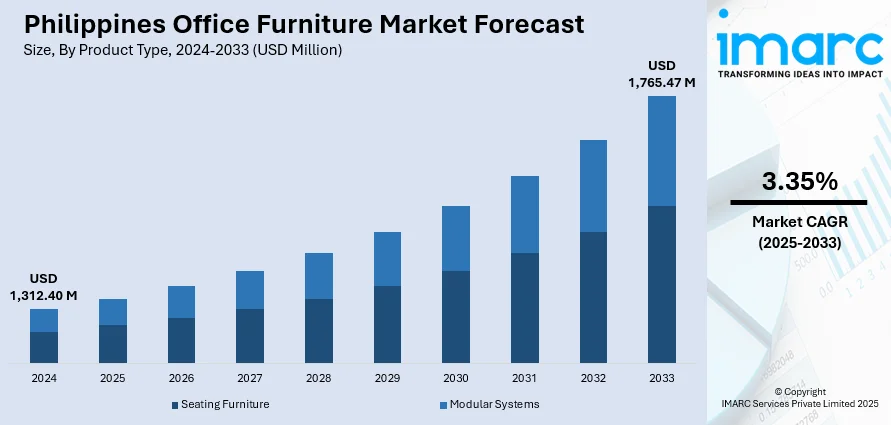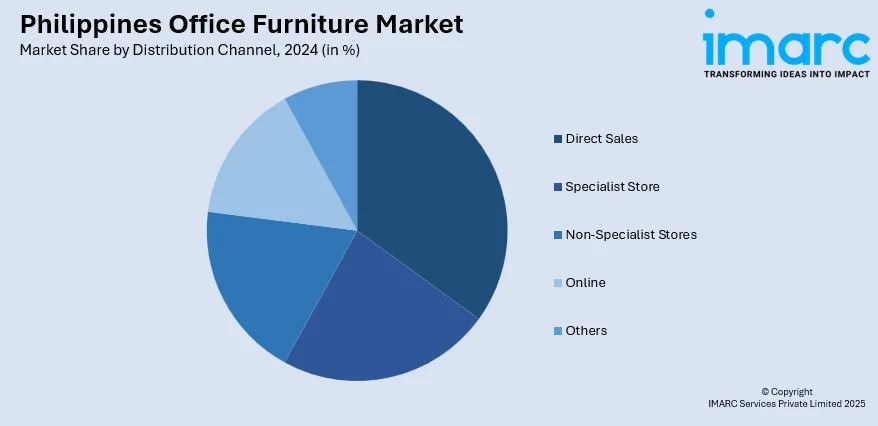
Philippines Office Furniture Market Size, Share, Trends and Forecast by Product Type, Material Type, Distribution Channel, Price Range, and Region, 2025-2033
Philippines Office Furniture Market Size and Share:
The Philippines office furniture market size reached USD 1,312.40 Million in 2024. Looking forward, the market is expected to reach USD 1,765.47 Million by 2033, exhibiting a growth rate (CAGR) of 3.35% during 2025-2033. Urban growth and the expanding digital economy are increasing the demand for flexible, modern office furniture in the Philippines. Companies now prioritize adaptable layouts, ergonomic designs, and multifunctional setups to optimize space, support collaboration, and enhance productivity in evolving work environments, thereby contributing to the expansion Philippines office furniture market share.
|
Report Attribute
|
Key Statistics
|
|---|---|
|
Base Year
|
2024 |
|
Forecast Years
|
2025-2033
|
|
Historical Years
|
2019-2024
|
| Market Size in 2024 | USD 1,312.40 Million |
| Market Forecast in 2033 | USD 1,765.47 Million |
| Market Growth Rate 2025-2033 | 3.35% |
Key Trends of Philippines Office Furniture Market:
Changing Work Patterns
Urban regions in the Philippines are growing swiftly, leading to an increase in startups, co-working spaces, and flexible work setups. Numerous businesses now focus on furniture options that optimize restricted floor area while ensuring functionality and comfort. Flexible designs, portable dividers, and modular workstations are becoming crucial, enabling teams to modify their work environments based on fluctuating personnel levels and project demands. Employers acknowledge that a friendlier and more flexible environment enhances employee satisfaction and retention. The International Trade Administration (ITA) forecasts that almost 102 million Filipinos will live in urban areas by 2050, highlighting the rising need for work environments that can support heightened city density. This trend ensures consistent business for local manufacturers and importers of versatile furniture that suits small offices while promoting teamwork without adding congestion. Conventional cubicle setups are slowly being substituted by versatile designs that adapt as required during the day. A couch can function as a casual meeting space during work hours and a place to unwind during breaks. Organizations aim to balance transparency with dedicated work areas, allowing employees to transition smoothly between solo tasks and collaborative discussions without spatial limitations. The ongoing demand for flexible interiors encourages suppliers to provide creative solutions that enable companies to stay competitive, draw in talent, and showcase a contemporary image to customers. As more businesses upgrade their workspaces to fit new work paradigms, the furniture industry is advancing to satisfy these functional and design needs.

To get more information of this market, Request Sample
Expansion of the Digital Economy
The sustained expansion of the digital economy is a significant factor driving the Philippines office furniture market growth. The increasing presence of technology-driven enterprises, e-commerce operations, and online service providers is creating a consistent requirement for adaptable and modern workspace solutions. These businesses frequently expand their workforce and require flexible furniture that can accommodate dynamic seating arrangements, collaborative work areas, and frequent spatial reconfigurations. According to the Philippine Statistics Authority (PSA), the digital economy of the Philippines reached PhP 2.25 trillion at current prices in 2024, contributing 8.5 percent to the country’s Gross Domestic Product. E-commerce, in particular, accounted for the highest share of employment within this sector at 77.9 percent, underlining the scale of workforce reliance on properly equipped work environments. Firms engaged in digital activities often refurbish office spaces to align with evolving operational demands and branding requirements. This pattern results in stable orders for ergonomic furniture, modular workstations, and integrated technology solutions. Local manufacturers benefit from supplying customized products, while importers address the demand for advanced designs. The continuous growth of the digital economy is projected to increase the demand for office furniture, as businesses keep focusing on workplace designs that boost productivity, promote employee well-being, and embody a contemporary corporate identity.
Growth Drivers of Philippines Office Furniture Market:
Rising Corporate and SME Growth
The expansion of small and medium enterprises, along with multinational corporations establishing offices in the Philippines, is fueling higher demand for quality office furniture. Growing investments in IT, finance, and outsourcing sectors are increasing the need for functional workspaces that improve employee productivity. As businesses scale, they require furniture solutions that not only accommodate more employees but also create efficient, professional, and modern environments. The shift toward well-designed office interiors is seen as essential for attracting talent and clients. According to the Philippines office furniture market analysis, this steady growth in corporate presence directly stimulates the demand for desks, chairs, storage units, and modular systems tailored to diverse office requirements.
Government and Infrastructure Development
Ongoing infrastructure projects and government support for commercial real estate expansion significantly impact the office furniture sector. Initiatives that promote economic zones, business districts, and office towers create long-term opportunities for furniture providers. With new office spaces continuously being developed in urban and suburban regions, the requirement for furnishing entire work environments grows rapidly. Additionally, policies encouraging entrepreneurship and foreign investment boost the creation of new businesses, further raising demand. The government’s focus on sustainable construction also increases demand for eco-friendly furniture solutions. Overall, supportive infrastructure development and regulatory policies act as catalysts, boosting Philippines office furniture market demand.
Growing Focus on Employee Well-being
Employee wellness has become a central factor influencing furniture purchases in Philippine offices. Companies are increasingly prioritizing ergonomic chairs, adjustable desks, and collaborative furniture to reduce health risks such as back pain and fatigue, while also boosting workplace efficiency. With greater awareness of the impact of furniture on mental and physical health, organizations are investing in innovative designs that foster comfort and productivity. Furthermore, the emphasis on open, collaborative spaces encourages the adoption of modern, versatile furniture that supports teamwork and creativity. This heightened focus on employee-centric work environments ensures sustained demand for advanced, ergonomic, and adaptive office furniture across industries.
Philippines Office Furniture Market Segmentation:
IMARC Group provides an analysis of the key trends in each segment of the market, along with forecasts at the country and regional levels for 2025-2033. Our report has categorized the market based on product type, material type, distribution channel, and price range.
Product Type Insights:
- Seating Furniture
- Modular Systems
The report has provided a detailed breakup and analysis of the market based on the product type. This includes seating furniture and modular systems.
Material Type Insights:
- Wood
- Metal
- Plastic and Fiber
- Glass
- Others
A detailed breakup and analysis of the market based on the material type have also been provided in the report. This includes wood, metal, plastic and fiber, glass, and others.
Distribution Channel Insights:

- Direct Sales
- Specialist Store
- Non-Specialist Stores
- Online
- Others
The report has provided a detailed breakup and analysis of the market based on the distribution channel. This includes direct sales, specialist store, non-specialist stores, online, and others.
Price Range Insights:
- Low
- Medium
- High
A detailed breakup and analysis of the market based on the price range have also been provided in the report. This includes low, medium, and high.
Regional Insights:
- Luzon
- Visayas
- Mindanao
The report has also provided a comprehensive analysis of all the major regional markets, which include Luzon, Visayas, and Mindanao.
Competitive Landscape:
The market research report has also provided a comprehensive analysis of the competitive landscape. Competitive analysis such as market structure, key player positioning, top winning strategies, competitive dashboard, and company evaluation quadrant has been covered in the report. Also, detailed profiles of all major companies have been provided.
Philippines Office Furniture Market News:
- In September 2024, Steelcase and UMCI Furniture Services Inc. launched The Space by UMCI, a state-of-the-art showroom in Makati, showcasing innovative workspace solutions. The event highlighted Steelcase’s ergonomic furniture, modular setups, and technology-integrated designs aimed at enhancing productivity and creativity. This dynamic showroom also served as a co-working space tailored for modern professionals.
- In May 2024, TWU Furniture and Sihoo officially launched their flagship ergonomic showroom at Ayala Malls Manila Bay in Parañaque City. The partnership showcased Sihoo's top ergonomic office chairs, including the popular M57 and premium Doro S300 models. These chairs were designed to enhance comfort, posture, and productivity, especially for remote work setups.
Philippines Office Furniture Market Report Coverage:
| Report Features | Details |
|---|---|
| Base Year of the Analysis | 2024 |
| Historical Period | 2019-2024 |
| Forecast Period | 2025-2033 |
| Units | Million USD |
| Scope of the Report |
Exploration of Historical Trends and Market Outlook, Industry Catalysts and Challenges, Segment-Wise Historical and Future Market Assessment:
|
| Product Types Covered | Seating Furniture, Modular Systems |
| Material Types Covered | Wood, Metal, Plastic and Fiber, Glass, Others |
| Distribution Channels Covered | Direct Sales, Specialist Store, Non-Specialist Stores, Online, Others |
| Price Ranges Covered | Low, Medium, High |
| Regions Covered | Luzon, Visayas, Mindanao |
| Customization Scope | 10% Free Customization |
| Post-Sale Analyst Support | 10-12 Weeks |
| Delivery Format | PDF and Excel through Email (We can also provide the editable version of the report in PPT/Word format on special request) |
Key Benefits for Stakeholders:
- IMARC’s industry report offers a comprehensive quantitative analysis of various market segments, historical and current market trends, market forecasts, and dynamics of the Philippines office furniture market from 2019-2033.
- The research report provides the latest information on the market drivers, challenges, and opportunities in the Philippines office furniture market.
- Porter's five forces analysis assist stakeholders in assessing the impact of new entrants, competitive rivalry, supplier power, buyer power, and the threat of substitution. It helps stakeholders to analyze the level of competition within the Philippines office furniture industry and its attractiveness.
- Competitive landscape allows stakeholders to understand their competitive environment and provides an insight into the current positions of key players in the market.
Key Questions Answered in This Report
The office furniture market in the Philippines was valued at USD 1,312.40 Million in 2024.
The Philippines office furniture market is projected to exhibit a CAGR of 3.35% during 2025-2033.
The Philippines office furniture market is projected to reach a value of USD 1,765.47 Million by 2033.
The Philippines office furniture market is shaped by growing demand for ergonomic designs, rising adoption of modular and flexible furniture, and the influence of hybrid work models. Increasing preference for sustainable, eco-friendly materials and smart furniture integration further define market trends, supporting productivity, comfort, and evolving workplace requirements nationwide.
The Philippines office furniture market is driven by rising corporate expansions, growing adoption of ergonomic solutions, and the shift toward hybrid workplaces. Increasing demand for flexible, modular setups and sustainable furniture designs further supports market growth, aligning with evolving business needs and modern workplace preferences.
Need more help?
- Speak to our experienced analysts for insights on the current market scenarios.
- Include additional segments and countries to customize the report as per your requirement.
- Gain an unparalleled competitive advantage in your domain by understanding how to utilize the report and positively impacting your operations and revenue.
- For further assistance, please connect with our analysts.
 Request Customization
Request Customization
 Speak to an Analyst
Speak to an Analyst
 Request Brochure
Request Brochure
 Inquire Before Buying
Inquire Before Buying




.webp)




.webp)












